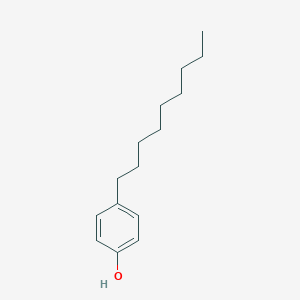| 1 |
Sulfation of environmental estrogens by cytosolic human sulfotransferases. Drug Metab Pharmacokinet. 2002;17(3):221-8.
|
| 2 |
Inhibitory effects of some possible endocrine-disrupting chemicals on the isozymes of human 11beta-hydroxysteroid dehydrogenase and expression of their mRNA in gonads and adrenal glands. Environ Sci. 2005;12(4):219-30.
|
| 3 |
[Effects of three environmental estrogens on expression of proliferation and apoptosis-associated genes in PEO4 cells]. Wei Sheng Yan Jiu. 2004 Jul;33(4):404-6.
|
| 4 |
Xeno-oestrogens and phyto-oestrogens are alternative ligands for the androgen receptor. Asian J Androl. 2010 Jul;12(4):535-47. doi: 10.1038/aja.2010.14. Epub 2010 May 3.
|
| 5 |
Identification of estrogen-responsive genes by complementary deoxyribonucleic acid microarray and characterization of a novel early estrogen-induced gene: EEIG1. Mol Endocrinol. 2004 Feb;18(2):402-11. doi: 10.1210/me.2003-0202. Epub 2003 Nov 6.
|
| 6 |
The xenoestrogens, bisphenol A and para-nonylphenol, decrease the expression of the ABCG2 transporter protein in human term placental explant cultures. Mol Cell Endocrinol. 2016 Jul 5;429:41-9. doi: 10.1016/j.mce.2016.03.034. Epub 2016 Mar 30.
|
| 7 |
Influence of hexabromocyclododecane and 4-nonylphenol on the regulation of cell growth, apoptosis and migration in prostatic cancer cells. Toxicol In Vitro. 2016 Apr;32:240-7. doi: 10.1016/j.tiv.2016.01.008. Epub 2016 Jan 19.
|
| 8 |
Endocrine-Disrupting Chemicals (EDCs): In Vitro Mechanism of Estrogenic Activation and Differential Effects on ER Target Genes. Environ Health Perspect. 2013 Apr;121(4):459-66. doi: 10.1289/ehp.1205951. Epub 2013 Feb 5.
|
| 9 |
Oncogenic Potential of Bisphenol A and Common Environmental Contaminants in Human Mammary Epithelial Cells. Int J Mol Sci. 2020 May 25;21(10):3735. doi: 10.3390/ijms21103735.
|
|
|
|
|
|
|



